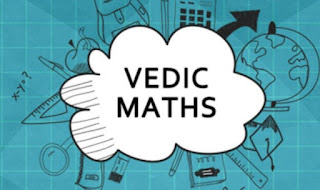VEDIC MATHS-43
VEDIC MATHS
By OMKAR TENDOLKAR
This is post number 43 from the series of "Vedic maths" blogs. Here in this blog we will learn about "Simultaneous Linear Equations part-3".
In the previous blog we studied how to solve two types of basic equations. In this blog we will study how to solve simultaneous linear equations.
What Are Simultaneous Linear Equations?
Simultaneous linear equations have two variables in them. Let us say x and y. Since there are two variables in the equation we cannot solve it by itself. We need another equation with the same variable values to find the answer. When these two equations are solved together we get the values of the variables x and y.
In the traditional method a new set of equations is formed in order to equalize the coefficients of any one variable. But forming new equations is a time-consuming procedure. Secondly, equalizing the coefficients is not always an easy task. If the coefficients have big numbers or decimal values it. becomes very difficult to equalize them by multiplying them with suitable numbers. the possibility of making a mistake with this method is pretty high.
Here in this blog we will study the Vedic approach to solving simultaneous linear equations.
Method:
In this method we will not be forming new equations but instead we will calculate the values of x and y with the given equations only. The value of the variables x and y will be expressed in the form of numerator upon denominator.
Numerator
Numerator
In previous blog we had observed that the technique for calculating the denominator is same in either method, viz. solving for x or solving for y. However, the technique of calculating the numerator is different in the second method.
However, one rule of thumb can be stated here which will help you in deciding which variable to solve.
"If the coefficients of x are big numbers than calculate the value of x and substitute for y and if the coefficients of y are big numbers than calculate the value of y and substitute for x"
(This happens because when you calculate the value of x you will be dealing with the y coefficients twice and hence avoiding the big x coefficients and vice versa.)
SPECIFIC CASE
There is a special sutra of Vedic Mathematics called the ‘Sunyam Anyat’ which says ‘If one is in ratio, the other is zero.’ This sutra is useful when the coefficients of either x or y are in a certain ratio.
Example:
1) 5x + 8y = 40
10x + 11y = 80
In the above case, the x coefficients are in the ratio of 1:2 (5:10) and the constants are also in the ratio of 1:2 (40:80).
Now, our sutra says that ‘if one (variable) is in ratio, the other one (the other variable) is zero.’
In this case, we see that the variable x is in ratio with the constant terms and therefore variable y, is zero. Thus, value of y is zero (y = 0). The value of y can be substituted as zero in the above equation. If we take equation (1) and substitute the value of y as zero, we have
5x = 40
hence, x= 8.
Solution:
x = 8, y = 0.
2) 67x + 302y = 1510
466x + 906y = 4530
The y coefficients are in the ratio of 1:3 (302:906) and the constants are also in the ratio of 1:3 (1510:4530).
Since the variable y is in the same ratio as the constant terms, the value of variable x is zero (x = 0).
We now substitute the value of x as zero in the first equation, and get the value of y
302y = 1510
hence, y = 5.
Solution:
x = 0, y = 5.
In this example, since the co-efficient and constant terms are big numbers it would have been very difficult to calculate the answer. But, because of Sunyam Anyat rule, we can easily solve them by detecting a ratio amongst the variable y.
In next blog we will discuss about "Base Method of Division part-1".
Thanks
for giving your valuable time.
Good day😊.


Wa wa mastach re bharu
ReplyDeleteThanks 😊
Delete